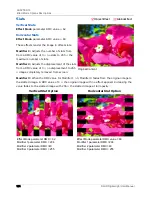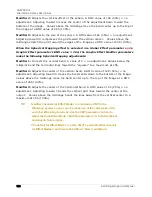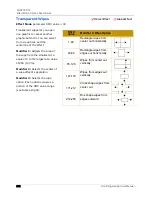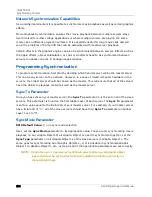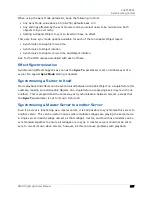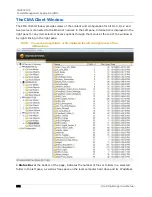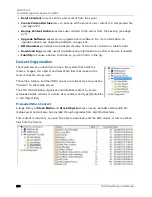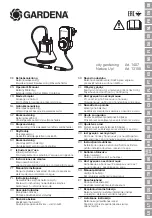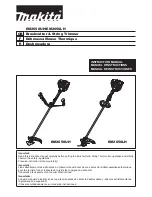
DLHD Digital Light User Manual
205
Chapter 14:
Synchronizing Content
After designating a master fixture, you can synchronize the content of
other DLHD, Axon HD, Axon, DL.3, or DL.2 fixtures to any Graphic Object
on the master in terms of playback time, rotation or both.
Network Synchronization Overview
Network Synchronization allows for certain functions of DL.3, DL.2 or Axon media servers to
be synchronized over an Ethernet network. This can be extremely useful in situations such as
using the Collage Generator to ensure a seamless image with multiple media servers.
Network Synchronization is done using a reference master server that sends certain
information about its current playback and output to the other fixtures on the network
through Ethernet packets. The other servers, or slave servers use this information to set their
playback and effects timing the same as the master server.
Network Synchronization is not slaving. With slaving, the master fixture’s DMX values for
synchronized functions would override the DMX values in the slave servers. When you use
Network Synchronization, the appropriate DMX channels for all the slave fixtures and the
master fixture must be set to the same values.
Network Synchronization Requirements
In order for Network Synchronization to function properly, there are a few requirements that
must be adhered to in the set-up of the fixtures:
• All of the servers must be linked on an Ethernet network. This network can be set up with
Auto-IP addresses or DHCP addresses.
• The Fixture ID for each media server in the network must be unique. The Fixture ID is
used to assign the master and slave servers and having multiple media servers with the
same ID will cause the Synchronization information being sent over the network to be
processed incorrectly.
A fixture ID default of 1 is assigned to every DL.3, DL.2 and Axon server on your Ethernet
fixture network. For synchronization to work, you will need to assign each DL.3, DL.2 and
Axon server a Unique Fixture ID from 1 to 255 using the CMA.
• All video content to be used in a Synchronization scenario MUST adhere to the High End
Systems requirements for encoding custom content for DL.3, DL.2 and Axon servers. If
the content is not encoded correctly, not only will the Network Synchronization not
function, but other problems with video playback (such as stuttering or jumping in the
clips) can occur.
Содержание DLHD High Definition Digital Light
Страница 8: ...viii DLHD Digital Light User Manual...
Страница 66: ...CHAPTER 5 DMX Programming Basics and Quick Start 44 DLHD Digital Light User Manual...
Страница 74: ...CHAPTER 7 Graphics Engine Overview 52 DLHD Digital Light User Manual...
Страница 128: ...CHAPTER 12 Global Functions Collage Generator 106 DLHD Digital Light User Manual...
Страница 226: ...CHAPTER 13 Effect Mode Options Descriptions 204 DLHD Digital Light User Manual...
Страница 230: ...CHAPTER 14 Synchronizing Content 208 DLHD Digital Light User Manual...
Страница 284: ...CHAPTER 16 CMA Warp Editor 262 DLHD Digital Light User Manual...
Страница 318: ...APPENDIX C Safety Information 296 DLHD Digital Light User Manual...




